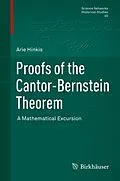This book offers an excursion through the developmental area of research mathematics. It presents some 40 papers, published between the 1870s and the 1970s, on proofs of the Cantor-Bernstein theorem and the related Bernstein division theorem. While the emphasis is placed on providing accurate proofs, similar to the originals, the discussion is broadened to include aspects that pertain to the methodology of the development of mathematics and to the philosophy of mathematics. Works of prominent mathematicians and logicians are reviewed, including Cantor, Dedekind, Schröder, Bernstein, Borel, Zermelo, Poincaré, Russell, Peano, the Königs, Hausdorff, Sierpinski, Tarski, Banach, Brouwer and several others mainly of the Polish and the Dutch schools. In its attempt to present a diachronic narrative of one mathematical topic, the book resembles Lakatos' celebrated book Proofs and Refutations. Indeed, some of the observations made by Lakatos are corroborated herein. The analogy between the two books is clearly anything but superficial, as the present book also offers new theoretical insights into the methodology of the development of mathematics (proof-processing), with implications for the historiography of mathematics.
Zusammenfassung
The chief purpose of the book is to present, in detail, a compilation of proofs of the Cantor-Bernstein Theorem (CBT) published through the years since the 1870's. Over thirty such proofs are surveyed.
The book comprises five parts. In the first part the discussion covers the role of CBT and related notions in the writings of Cantor and Dedekind. New views are presented, especially regarding the general proof of CBT obtained by Cantor, his proof of the Comparability Theorem, the ruptures in the Cantor-Dedekind correspondence and the origin of Dedekind's proof of CBT.
The second part covers the first CBT proofs published (1896-1901). The works of the following mathematicians is considered in detail: Schröder, Bernstein, Bore, Schoenflies and Zermelo. Here a subtheme of the book is launched; it concerns the research project following Bernstein's Division Theorem (BDT).
In its third part the book covers proofs that emerged during the period when the logicist movement was developed (1902-1912). It covers the works of Russell and Whitehead, Jourdain, Harward, Poincaré, J. König, D. König (his results in graph theory), Peano, Zermelo, Korselt. Also Hausdorff's paradox is discussed linking it to BDT.
In the fourth part of the book are discussed the developments of CBT and BDT (including the inequality-BDT) in the hands of the mathematicians of the Polish School of Logic, including Sierpiski, Banach, Tarski, Lindenbaum, Kuratowski, Sikorski, Knaster, the British Whittaker, and Reichbach.
Finally, in the fifth part, the main discussion concentrates on the attempts to port CBT to intuitionist mathematics (with results by Brouwer, Myhill, van Dalen and Troelstra) and to Category Theory (by Trnková and Koubek).
The second purpose of the book is to develop a methodology for the comparison of proofs. The core idea of this methodology is that a proof can be described by two descriptors, called gestalt and metaphor. It is by comparison of their descriptors that the comparison of proofs is obtained. The process by which proof descriptors are extracted from a proof is named 'proof-processing', and it is conjectured that mathematicians perform proof-processing habitually, in the study of proofs.Inhalt
Preface. - Part I: Cantor and Dedekind.- Cantor's CBT proof for sets of the power of (II).- Generalizing Cantor's CBT proof.- CBT in Cantor's 1878 Beitrag.- The theory of inconsistent sets.- Comparability in Cantor's writings.- The scheme of complete disjunction.- Ruptures in the Cantor-Dedekind correspondence.- The inconsistency of Dedekind's infinite set.- Dedekind's proof of CBT.- Part II: The early proofs.- Schröder's Proof of CBT.- Bernstein, Borel and CBT.- Schoenflies' 1900 proof of CBT.- Zermelo's 1901 proof of CBT.- Bernstein's Division Theorem.- Part III: Under the logicist sky.- Russell's 1902 proof of CBT.- The role of CBT in Russell's Paradox.- Jourdain's 1904 generalization of Grundlagen.- Harward 1905 on Jourdain 1904.- Poincaré and CBT.- Peano's proof of CBT.- J. Knig's strings gestalt.- From kings to graphs.- Jourdain's improvements round.- Zermelo's 1908 proof of CBT.- Korselt's proof of CB.- Proofs of CBT in Principia Mathematica.- The origin of Hausdorff Paradox in BDT.- Part IV: At the Polish school.- Sierpiski's proofs of BDT.- Banach's proof of CBT.- Kuratowski's proof of BDT.- Early fixed-point CBT proofs: Whittaker; Tarski-Knaster.- CBT and BDT for order-types.- Sikorski's proof of CBT for Boolean algebras.- Tarski's proofs of BDT and the inequality-BDT.- Tarski's Fixed-Point Theorem and CBT.- Reichbach's proof of CBT.- Part V: Other ends and beginnings.- Hellmann's proof of CBT.- CBT and intuitionism.- CBT in category theory.- Conclusion.- Bibliography.- Index of names.- Index of subjects.
